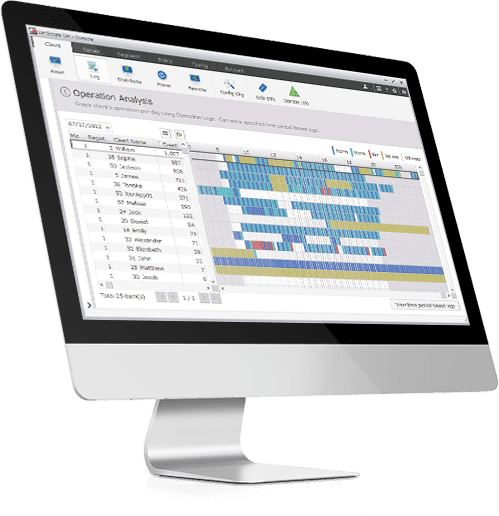Banking & Financial Institutions
Protection To Bank On
Banks and financial services firms confront cybersecurity attacks 300 times more frequently than in any other industry. Criminals from inside and outside target financial companies because that’s where the money is. These companies are challenged to balance being open with being secure.
LanScope Cat helps alleviate the risk to financial services companies by delivering a complete endpoint management product built with AI and real-time processes helping IT teams streamline operations and eliminate hands-on activity to speed response to potential attacks.

Automated
Using AI, identify and prevent malware and memory-based attacks on online or offline endpoints by automatically recognizing devices, empowering security teams with a real-time dashboard to assess the extent of a threat and if endpoints are infected.

Easy to Use
Provides automatic detection of USB activity, supports remote configuration with simple management of power saving, streamlines asset and device management and instantly updates repositories and synchronizes software versions – freeing IT teams to address other critical issues.

Comprehensive
Delivers real-time insights on device activity; reports on malware activity in a prioritized detailed, and action-based management dashboard; and monitors every device connected to the network, ensuring all endpoints are fortified with the latest agents.
CASE STUDY
Bank Detects Malware
The Struggle
Our financial industry client, a bank with over 1,200 endpoints, struggled with pervasive malware attacks and infections. They installed Cylance to detect and quarantine the problematic threat, but it continued to reoccur day after day.
The Solution
First, the client tried to interview their users to determine the malware source. After this method did not reveal suspicious behaviors. They purchased a well-known, expensive cyber tool, but were still unable to source the malware. Finally, they installed LanScope Cat.
The Result
LanScope Cat allowed them to review detailed user activity logs and pinpoint the initial source of the malware – a website. The company quickly enabled a policy within LanScope Cat to block the website and prevent future exposure.
View. Manage. Protect.
Are You Doing Enough For Security?
Protect & Manage Your IT Before It Gets Out of Control
As your company grows, so do the number of endpoints you have to protect. Did you know over 61% of small businesses experienced a cyber attack in 2016? Hackers see small businesses as easy targets. LanScope Cat changes that.
LanScope Cat protects every single endpoint on your network by allowing you to define and enforce your own company policy. Our easy-to-use console allows you to monitor web activity, external device usage, USB usage, printing activity and more!
Asset Management
Get greater visibility into your assets and how users actually use them. Continual logging gives you a complete picture of the state of your network and what is happening to your data. Establish and enforce policies. Verify system updates and patches have been installed. Track license inventory and usage.
Employee Monitoring
Understand what kinds of activities are actually taking place within your environment and determine patterns of intentional or accidental use. Address serious violations when they occur, through clear and comprehensive activity logs.
Web Access Monitoring
See which users are accessing which websites and for how long. Block access to unauthorized websites and prevent users from accessing restricted URLs and keywords.
USB/External Device Management
Automatically detect USB activity, including usage and idle time, to obtain an instant update of all peripheral activity. Manage remote users and devices to ensure policy compliance and security.
Malware Protection with Cylance
Identify and prevent known and unknown malware and memory-based attacks on online or offline endpoints. LanScope Cat regularly scans every network device to ensure all endpoints are fortified with the latest agents. The dashboard shows files that were detected and quarantined.










